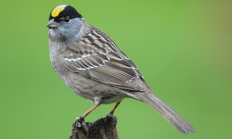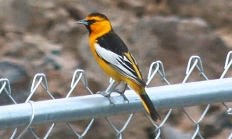Search myodfw.com
The Swamp sparrow uses wet areas that have thick vegetation for cover. Several glimpses of this reclusive bird may be required before it can safely be separated from Lincoln's sparrow or the more common Song sparrow, though its distinctive call will give it away to observers familiar with it. Chestnut coloration on the wing coverts helps separate this species from other wintering sparrows. The Swamp swallow is a rare to uncommon spring and fall transient and winter visitant in western Oregon, especially along the coast. Hear the song of the Swamp sparrow Photo from USFWS

Familiar to anyone from the eastern United States and Canada, this sparrow is much less common in Oregon. Adults show both a white-striped and tan-striped morph, while first year birds resemble tan-striped adults but are typically more heavily streaked underneath. Even the dullest first-year birds have a distinct rectangular white throat patch, often set off with a partial black border. The White-throated sparrow is an uncommon migrant and winter visitor, mainly in western Oregon. Hear the call of the White-throated sparrow Photo by ©Keith Kohl, ODFW

This large sparrow is white below and in most plumages has at least some black around the face or throat, more in adults than younger birds. Cheeks are golden-tan in fall and winter and grayish in spring. It is streaked above. It is a winter visitor usually found with other sparrows. A very rare migrant and rare but regular visitor, you can find the Harris's sparrow statewide. Numbers vary considerably from year to year, but a few birds are typically found in the state every year. They are most regular in the Columbia Basin and in valleys within the Blue

This large brown sparrow with its handsome black-and-white head pattern is a common breeder in brushy semi-open country throughout much of the state. In winter, it is frequently found in large flocks, often in the company of Golden-crowned sparrows and other seed eaters. White-crowns are easily seen as they feed on the ground, repeatedly dashing back into the cover of dense shrubs before emerging for another foraging bout. Hear the song of the White-crowned sparrow Photo by Kathy Munsel, ODFW

Flocks of these big, brown, plain sparrows are a common sight in winter in western Oregon. By early spring their faded head markings become a beautiful gold, black and white, and their plaintive descending songs become frequently heard from almost any large brush pile. They are an abundant migrant in western Oregon, less common farther east, and abundant in winter throughout the Willamette Valley. Hear the song of the Golden-crowned sparrow Photo by Dave Budeau, ODFW

This small, dark-headed sparrow flashing white outer tail feathers is one of the state's most abundant species and one of the easiest to identify. When not nesting, the Dark-eyed junco might be seen nearly anywhere in the state. It is a regular visitor to city parks and neighborhood bird feeders. Most juncos occurring in Oregon show dark hoods, dull rusty-brown backs, and pinkish brown below the wings. Some are grayish, lacking much of the brown tones. They are most often observed in single-species flocks but individuals and small groups often join mixed wintering sparrow flocks. It is resident from the

Within wintering flocks of Horned Larks in the valleys of eastern Oregon, and along flats bordering coastal estuaries in the fall, it is sometimes possible to find flocks of this large arctic-breeding sparrow. Their habit of running along the ground in a crouch rather than flying makes them a challenge to observe, but in flight their characteristic rattling call is unmistakable. Otherwise, in fall and winter plumage, they appear as brownish streaked sparrows. In flight their dark tail with white sides is conspicuous. Along the outer Oregon coast, the Lapland longspur is an uncommon but regular fall migrant, especially at

The Snow bunting is a large finch that breeds throughout the high arctic tundra. In winter, many move south, sometimes forming large flocks in open grasslands, steppes, and dunes. When feeding in agricultural fields, these flocks may be hidden among the stubble, but when alarmed they often arise as a group and whirl about in a white cloud before returning to their spot or a nearby one. Oregon is at the southern edge of their winter range, and their wanderings about the state are erratic. In basic plumage, they are buffy and cream-colored with black and white wings. Hear the

This species breeds from northeast British Columbia to Nova Scotia and south to north Georgia. It winters in Middle and South America. Small numbers regularly occur along the west coast, especially in spring. The majority of Oregon records have occurred from early March through July, mostly from mid-May to mid-June. Individuals are occasionally found from mid-September to mid-January, mostly birds that remained less than five days. Here the song of the Rose-breasted grosbeak Photo by Anna Hesser, Flickr

For many, the rich, melodious song of the Black-headed grosbeak is the music of springtime in Oregon. The handsome males, with their bold pattern of cinnamon, black, and white, are among our most striking songbirds, and area familiar site in parks and gardens as well as in almost every forest type in the state. The buffy, streaked females are less conspicuous, but are also accomplished singers. The Black-headed grosbeak is a common to fairly common breeder and common migrant in forested regions throughout the state. Hear the song of the Black-headed grosbeak Photo by David Bronson

All of Oregon's blue-colored birds are appreciated for their dazzling appearance, but the striking plumage of this summer visitor is accompanied by a song described as vivacious, varied, well-articulated and sweet. Males are unmistakable when singing from a prominent perch, flashing deep azure upper parts with rich orange-brown breast and flanks, a white belly, and white wing bars. Females are warm brown and relatively plain, though they share with males the habit of twitching the tail to one side when excited. The Lazuli bunting is fairly common in low-elevation dry valleys in Curry County but are becoming uncommon north through

Observers can see mixed flocks of Oregon's four species of blackbirds, the Great-tailed grackle and the Brown-headed cowbird.

The male Red-winged blackbird, sentry of the marsh during the breeding season, continually announces its territory to all present with its oak-a-tee song, and tenaciously defends against flyby predators. The male is territorial, polygynous, larger than the female, and glossy black with a broad bar of red-orange, bordered with yellow, on wing writs. Females are less conspicuous in behavior, light brown, with a heavily streaked breast, and buffy supercilium. This is one of the most abundant and studied birds in North America. The Red-winged blackbird occurs west of the Cascades in Oregon from coastal and valley locations, and east of

The gregarious Tricolored blackbird is one of North America's most intensely colonial breeders, forming dense, non-territorial, noisy colonies. A highly synchronized nesting system exploits secure nesting locations and rich food supplies that change from year to year. In Oregon, breeding colonies are scattered and intermittent at specific locations, though sites used during consecutive years may be in the same general area. The Tricolored blackbird breeds most consistently in Klamath and Jackson Counties. Small colonies and summering residents have been found in the Willamette Valley; during fall and winter they are rare. Most retreat south to California in winter, while some

In grass or sagebrush-dominated habitats throughout the state, the song and striking appearance of the Western meadowlark create one of the most familiar and endearing avian images in Oregon. It's one of Oregon's most recognizable birds with its bold yellow breast and belly with a distinct black V across the chest and its habit of perching on fences along roadsides. Fittingly, it was chosen as Oregon's state bird by a vote of Oregon schoolchildren ratified by the Legislature in 1927. It is one of the most widely distributed open-country species in the arid desert country of eastern Oregon. It can

The song of the Yellow-headed blackbird, if it can be called a song as it lacks any musical quality, is a familiar sound in the marshes particularly of central and southeastern Oregon. The male, with its yellow head, neck, and breast, black body and wings, and white wig patches, is unmistakable. The female is more subtle with its dusky or sooty brown body plumage and yellow cheeks, chin, throat and chest, but is also distinctive. It is an abundant spring and summer resident in marshes of large alkaline lakes and wetlands in southeast Oregon, most notably the Klamath, Summer, Malheur

Highly adaptable, this ubiquitous species may be found in habitats as diverse as coastal marshes, sagebrush, shrub-steppe, and urban supermarket parking lots. The adult male is blackish, showing a purplish sheen on the head and a greenish sheen on his back. Its eyes are yellowish to creamy white. Females and juveniles are dusky brown above and grayish brown below, with paler throat and eyebrows, and brown eyes. The Brewer's blackbird is a common permanent resident along the coast. West of the Cascades it is common to abundant in inland valleys. Within the Cascades, they are a migrant and summer resident

The Brown-headed cowbird was referred to in early literature as the "buffalo bird" presumably because it commonly foraged on insects flushed under the feet of ungulates. It is a brood parasite, laying its eggs in nests of other species and leaving the rearing of young to surrogate parents. This has had serious consequences for many host species within the cowbirds' range. In Oregon, the Brown-headed cowbird is a common migrant and breeder in open habitats and woodland edges in all parts of the state. It is most abundant in agricultural land, sagebrush and juniper steppe, coastal scrub, riparian zones, and

A boldly colored medium-sized bird, the Bullock's oriole builds its characteristic hanging nest in broadleafed trees and tall shrubs, especially when the trees or shrubs are spaced widely and situated along the edges of streams and fields. In Oregon, the Bullock's oriole is a rare to fairly common breeder, especially along major rivers and around farmsteads. It is most widespread in southwest and northeast Oregon. In particular, on the Derby Road in Jackson County. It nests primarily in open spaced cottonwoods, maples, and other tall, forking broadleaf trees. The nest is constructed of plant fibers, hairs, fine grass, and moss

Small to medium-sized, finches have relatively pointed wings and sparrowlike bills. They have notched, short tails and and constantly give calls in flight.

